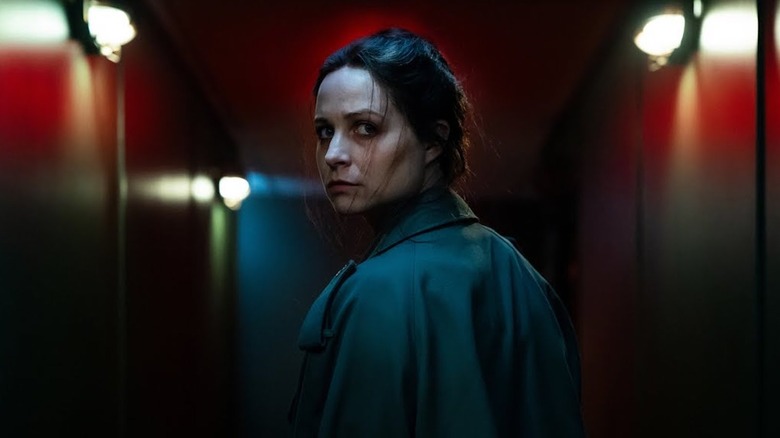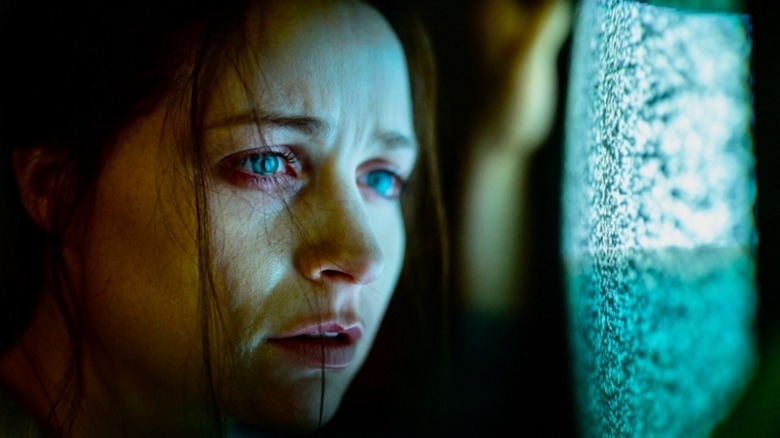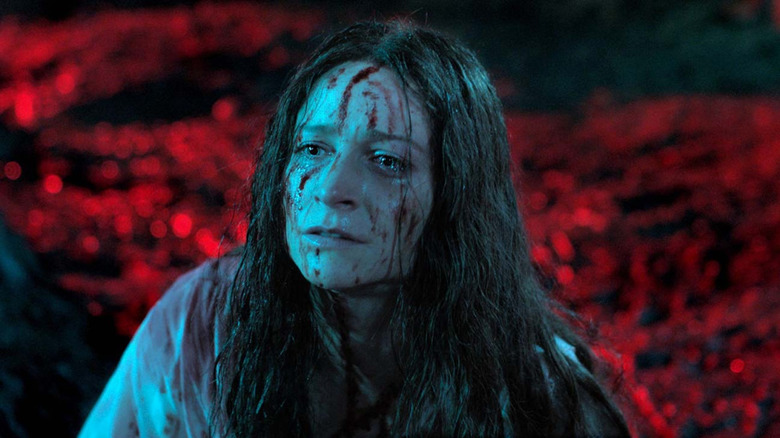Censor Director On The Perverse Joke Of Building A Violent Horror Movie Around A Film Censor [Interview]
"Censor" is a horror movie about a very specific time and place. That time: the 1980s. The place: the United Kingdom under Prime Minister Margaret Thatcher. It's an era that has inspired all kinds of horror stories, and one that really had it out for, well, actual horror stories. Government censors worked overtime to edit, and often ban, violent horror movies, which were dubbed "video nasties." The result: an underground network of horror enthusiasts who were subject to literal police raids for owning the wrong VHS tapes, and scrappy filmmakers whose dabbling in violent cinema made them outlaws.
It's in this world that director and co-writer Prano Bailey-Bond introduces us to Enid, a censor who spends her days counting frames of violence in her government office, debating how many moments of gore should be allowed in horror movies. But Enid isn't just some scolding prude out to "get" horror cinema. Her sister vanished when she was young, and if her work can prevent even one maniac from being "inspired" to commit a violent crime, she has fulfilled her mission. But "Censor" is a horror movie. And that means Enid's life amidst gruesome cinema takes a very literal twist as she uncovers something shocking within a film she's assigned to review, sending her spiraling into a bloody horror tale of own.
Part of the fun of "Censor" is how Bailey-Bond slowly transforms Enid's world into a "video nasty" torn straight from her own work, invisibly transitioning its style from cold, staid, and clinical to vibrant, unhinged, and out-of-control. The film is a treat for horror fans interested in this era (the details are fascinating), but it succeeds without requiring prior knowledge. It's an extremely entertaining and stylish descent into madness.
/Film spoke with Bailey-Bond about her work on "Censor" (which hits home video and streaming today) and the lingering hangover of Thatcher's Britain on modern U.K. horror fans.
This interview has been edited for clarity.
"It's basically the starting point of a bigger conversation about horror."
As an American whose biggest barrier to horror films growing up was my mom saying no to them, I've always been curious about horror fandom in the U.K. Has there been an aftermath, like a lingering hangover, for horror fans from the '80s and everything covered in "Censor"?
Yeah, I definitely think there has been, 100%. I was really, really young when the Video Nasty era was kind of in full swing. So I was discovering these films more as a teenager, but the people who were being demonized for this, like some of my friends who I now know, who were having their houses raided for having like a few horror films in their house, I think there is a lingering residue for sure off the back of that. And I actually think it kind of gave birth to what is the UK horror scene today because those people were banding together to be able to enjoy the horror films that they loved and creating fanzines and sending second, third, fourth generation copies of "Texas Chain Saw Massacre" around the UK so that other people could actually have a chance to watch those films. So I think it kind of almost gave birth to like an underground culture that is now the horror scene over here.
There's almost something delightfully perverse about a U.K. horror film where the main character is a censor.
Yeah. I did think about that. You're obviously making something that you hope is going to reach horror fans and "the censor is the enemy," so they can just hate her right from the start because she's the person stopping you from watching what you love. I was really interested in making a film about a censor because I felt like if these violent images are supposed to make us commit violent acts, what is it that prevents the censor from losing control?
That was kind of the first question I started with in my head. And I just thought, imagine if you had a film censor who believed so much in censorship, that they started to think that the films might be having an effect on them or that if they started to make them have a complicated conversation with their own moral compass. So I was really drawn to talking about a film censor in a film, also because it gives you room to talk about our relationship with horror. And it's basically the starting point of a bigger conversation about horror. And I hadn't really seen a film about a film censor either.
I don't know why. I don't know why there aren't more, but I know that when we showed the BBFC, the British Board of Film Classification over here, they said it was the first time they've seen their work reflected back on screen, which they were quite excited by actually.
I was really compelled by the early scenes, where it's just a day in the life of a film censor office — watching how they worked, how they took notes, how they interacted in the office, how they clinically discussed the acts of gore on screen. Can you talk about the research that went into building a believable workplace like that?
We went into the BBFC quite early on in the writing process, me and my co-writer, and talked to them about how they work today and how they worked then. And a lot of it's quite similar to today and then, and lots of it's changed massively. So for example, they always view in pairs, and if there's a problematic title, a wider group will watch and then they'll discuss and they keep all their notes, which we were able to go and actually look through the notes and look through the files from the period, because once a film is over, I think, 15 years old, the public can go and access that file.
So I was able to look through the file for "The Evil Dead," from "The Texas Chain Saw Massacre," and "Possession" and things. And that was really fascinating because you start to see the different personalities of the censors and the different obsessions and the clashing opinions over these films as well. Like some of them really defending "Possession" and someone else saying this is a mighty bore, all this very intellectual language and kind of highly educated approach to these really fun, gory, silly films, which is really quite amusing. So there was a lot of fun research that we did to sort of establish the characters, but also the space that they were working in.
"And I'm glad that it creeps up on you because that was always the intention."
I think horror has transformed most ardent fans into historians of the genre. And I love the idea of the censors accidentally creating an archive, a treasure trove of information, for you to dive into.
Yeah, totally. I mean, they really did. And you're right. I mean, that's the thing about horror fans. They're so dedicated and they see everything and that was something I was really thinking about when I was making this because over here, a lot of the horror fans, they lived through this period as well, so they kind of experienced it firsthand and they've got their own relationships with these films. And so you're kind of constantly wanting to make sure that you get the facts and things right. That's one of the reasons we didn't have all of the films [featured in "Censor"] be real films because when I was making my short film "Nasty," I thought "If we have 'The Evil Dead' in this, we might have somebody come in and be like, oh, well, this film's set in 1982." Those kinds of personal factual relationships with these films that can suck someone very suddenly out of the story.
But [what] I love that about horror and about the horror audience that you can almost be having another conversation with a horror audience. There's like a whole language in horror that is inspired by the previous horror films that have existed and you can take something like the jump scare as an example. You have like the whole thing of somebody being in the mirror as you close it. And then there's a point where there's no one in the mirror and like how that whole evolution of the mirror jump scares evolved. I just think that's all really fun. It's fun to play with as a filmmaker as well.
Can you talk about the sequences where you recreate the Video Nasties from the '80s? I'm curious about the choices you made to depict the characters and the situations.
Each of the Video Nasties, the films within the film, definitely had very specific references and you're trying to conjure an atmosphere that's quite haunting because Enid is haunted in those moments by her past and her sister's disappearance. So it was a balance, for example, with "Asunder," the one where she sees Alice Lee, I had to really hold back from going too silly in that, because you could turn that into quite an over-the-top sort of silly scene. But it had to be haunting and eerie because Enid feels like she's seen a ghost in that moment. That was a really fun one to design. You're taking this idea of like this big creaky old house and this library and the kind of colors and the costume, everything was just really, really fun to put together.
But then you're also looking at how you shoot that to kind of really feel the era. And that's going back and watching lots of films, and thinking about style and thinking about how directors from that period would have been shooting stuff. And then trying to kind of shoot it as much as possible, like a director from that period.
The film starts off looking nothing like the video nasties that are at its core. And then as it goes on, you start to bend reality and shift how the film looks. Can you talk about how you managed to slowly ease into that? I didn't realize the style has shifted until it was too late.
It was something that I always wanted to feel like a gradual descent because it's all reflective of Enid's psychological state. And so that's a slow, gradual decline rather than a 180 flip way like, "Whoa, suddenly I'm in a whole other universe." And so it was really about finding where we start with certain elements so that we had somewhere to go with them. So for example, the colors at the beginning of the film are really very, very sort of oppressive, with blues and grays and much more of the era like we're looking at, like gray, bleak. And so I was referencing photography from the era that was kind of quite dowdy and we were trying to make the characters feel very much like they belonged to the world so their costumes really kind of marry with the colors and the set design and things like that.
But that means that you've got somewhere to go. So later on, you can start to introduce slightly brighter, more vivid colors in the costumes. And similarly with Enid's hair, you've got her all done up and tight bun and as she becomes more and more out of control, her hair becomes more and more out of control. And so it's finding those places to start from and the same thing with the camera movements. It's very still at the beginning and we start to move when Enid moves. And then at a certain point, we go handheld and it's kind of always taking it back to character and reflecting what's going on for her, but it was a lot of fun to design that stuff.
And I'm glad that it creeps up on you because that was always the intention. I kind of imagined that you're weaving things in and out of her dreams and back into reality. So you'd go into a dream and you see maybe pink or purple for the first time. And then when you come back to reality, you're just weaving a little bit of that color into her real world. And it sort of reflects in the same way, like Enid sort of taking an element of reality, fiction, memory and dream, and sort of creating a new narrative out of that. So yeah, it was fun to make all that stuff.
"Censor" is now on DVD and On Demand. It is available to stream on Apple TV, DirecTV, Google Play, Prime Video, FandangoNOW, and more.


